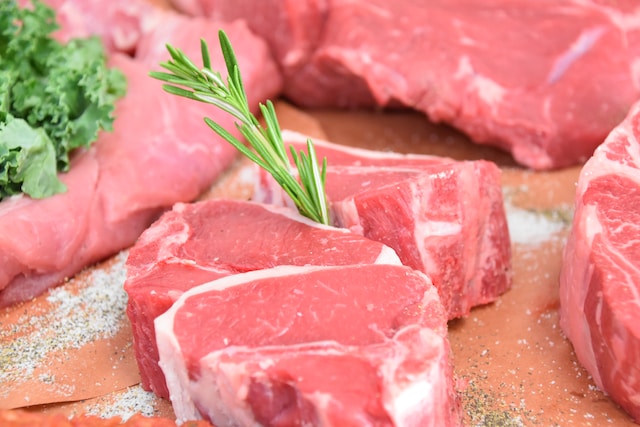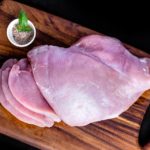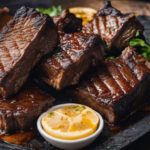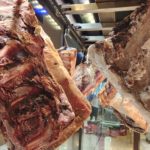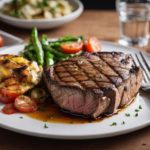Confused by the many cuts of pork at your local supermarket? You’re not alone. Pork is an incredibly versatile meat, with each cut offering a different flavor and texture. This comprehensive guide will demystify the world of pork cuts for you, explaining what each cut is best suited for and how to cook it perfectly every single time.
Ready to become a pork connoisseur? Let’s dive in!
Key Takeaways
- Pork shoulder is a flavorful cut of meat that is best cooked slowly and used in dishes like pulled pork.
- Pork loin is a lean and tender cut that can be used to make pork chops or roasts, but be careful not to overcook it.
- Pork belly has rich flavor and can be used to make bacon or crispy pork belly bites.
- Pork hock is a versatile cut that adds depth and richness to soups, stews, braises, and even ham.
Primal Cuts of Pork

The primal cuts of pork include the shoulder, leg, loin, belly, and hock.
Shoulder
Pork shoulder is a tasty cut. It comes from the pig’s upper part. Its meat is full of flavor and fat. This makes it good for long, slow cooking times. You’ll often find this used in pulled pork dishes, where it gets cooked low and slow until super tender.
The Boston butt is also part of the shoulder, but not the same thing as pork butt! Smoky barbecue loves to use this cut too for best results! Don’t get confused between pork shoulder and pork butt even though they come from the same area – each has unique uses.
Leg
The leg, or often called the pork leg, is a good meat part to make roasts. You get this cut from the back of the pig. It is juicy and lean meat that tastes great when you cook it slow and low.
This way gives best results because it makes sure all flavors mix well.
You can also smoke or braise a pork leg for a deep and rich taste. Some people cut the leg into steaks or use ground pork from it for extra tasty dishes. Other people cure and smoke it to turn it into ham.
The “low and slow” cooking style keeps this tender meat juicy while cooking.
Loin
The loin is a yummy part of the pig. It sits on the back, between the shoulder and leg. This cut has lean meat that’s soft when you eat it. Many people love pork chops and they come from this part too! The loin roast also comes from here.
It’s best to cook it slow for a tender bite. But be careful not to overcook it, as this can make it dry out. With its juicy taste and soft texture, no wonder the loin is a favored pick among pork lovers!
Belly
The belly is a delicious cut of pork that is known for its rich flavor and tender meat. It comes from the underside of the pig, and it’s often used to make bacon or pork belly dishes like crispy pork belly bites.
The belly has layers of fat and lean meat, which give it a juicy texture when cooked properly. It can be braised, roasted, or grilled to create mouthwatering dishes. When buying pork belly, look for slices that have a good balance of fat and meat.
Proper storage techniques will help keep it fresh longer.
Hock
The hock is a cut of pork that comes from the lower part of the pig’s leg. It is often used in dishes like soups, stews, and braises because it has a lot of connective tissue which makes it flavorful when cooked slowly.
The hock can also be smoked or cured to make delicious ham. It is a versatile cut that can add depth and richness to your cooking. So next time you’re at the butcher shop, don’t forget to ask for some pork hocks! They are perfect for creating hearty and tasty meals.
Retail Cuts of Pork

The retail cuts of pork include pork chops, pork loin chops, pork shoulder chops, pork crown roast, pork cutlets, and more.
Pork chops
Pork chops are a popular cut of pork that many meat lovers enjoy. They come from the loin, which is located on the upper part of the pig. Pork chops are known for being lean and tender, making them perfect for grilling or pan-frying.
They can also be breaded and fried to create a delicious crispy coating. Pork chops can be boneless or bone-in, with each option offering its own unique flavor and cooking experience.
When buying pork chops, look for ones with a pinkish color and minimal visible fat. It’s best to cook pork chops to an internal temperature of 145°F (63°C) to ensure they are safe to eat but still juicy and flavorful.
Pork loin chops
Pork loin chops are a delicious and versatile cut of meat that can be cooked in various ways. These chops come from the upper part of the pig’s back, near the spine. They are lean and tender, making them perfect for grilling or pan-frying.
Pork loin chops have a mild flavor and can be seasoned with herbs, spices, or marinades to add extra taste. They cook relatively quickly and should be cooked to an internal temperature of 145°F for juicy and tender results.
Whether you prefer them grilled, seared on a stovetop, or roasted in the oven, pork loin chops are sure to satisfy your meat cravings!
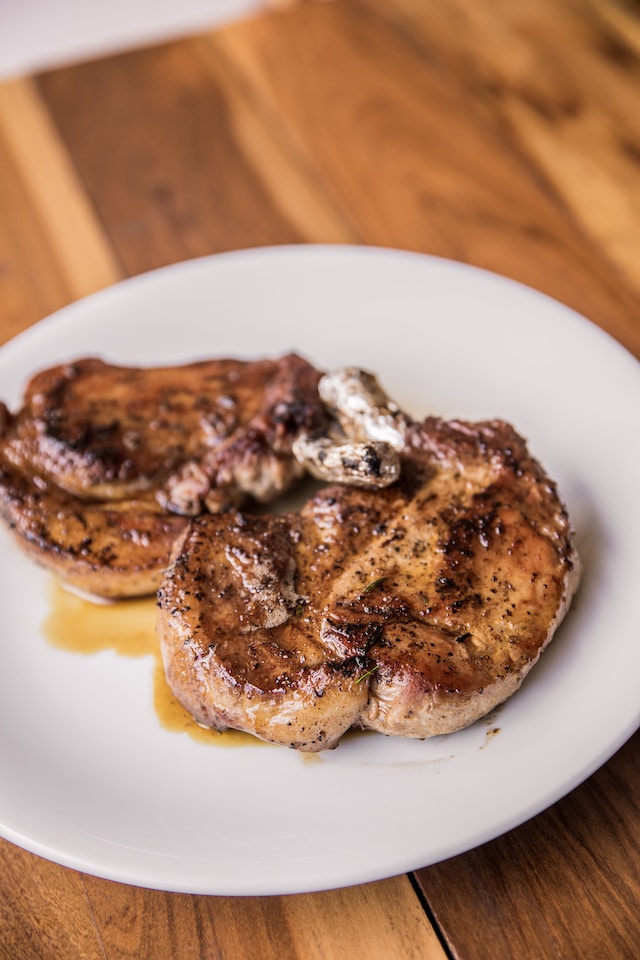
Pork shoulder chops
Pork shoulder chops are a flavorful and affordable cut of pork that are great for grilling or slow cooking. They come from the upper part of the pig’s shoulder, which is why they’re sometimes called “boston butt” or “pork butt.”.
These chops have marbling and connective tissue, which makes them juicy and tender when cooked properly. You can grill them over high heat to get a delicious charred crust, or you can braise them in liquid for a melt-in-your-mouth result.
Pork shoulder chops are versatile and can be used in various recipes like pulled pork sandwiches, stews, or even sliced into thin strips for stir-frying. They’re also budget-friendly, making them an excellent choice for feeding a crowd without breaking the bank.
Pork crown roast
The pork crown roast is a special and impressive cut that’s perfect for a fancy dinner or holiday meal. It’s made by tying together two racks of pork loin chops in a circle, creating a beautiful crown shape.
The meat is juicy and flavorful, with the bones adding extra taste. When cooked properly, the pork crown roast becomes tender and succulent, making it a real showstopper on any dining table.
This cut is often roasted to perfection, resulting in crispy skin and moist meat inside. It’s important to note that the pork crown roast may require longer cooking time compared to other cuts due to its size and bone-in nature.
Pork cutlets
Pork cutlets are a delicious and versatile cut of pork that can be enjoyed in many different ways. They are thin slices of meat that come from the loin or leg of the pig. These cuts are lean and tender, making them perfect for quick cooking methods like frying or grilling.
Pork cutlets can be breaded and fried to make crispy schnitzels, marinated and grilled for a flavorful main dish, or even used in stir-fries and sandwiches. They cook up quickly and are full of juicy flavor, making them a popular choice for meat lovers everywhere.
Whether you’re looking for an easy weeknight dinner or wanting to impress your guests with a tasty meal, pork cutlets are sure to satisfy your cravings!
Pork back ribs
Pork back ribs are a delicious and juicy cut of meat that come from the upper part of the pig’s back. These ribs have tender meat with a good amount of fat, making them incredibly flavorful.
They are often used for barbecue or grilling because they cook up beautifully and develop a tasty caramelized crust. One important thing to note is that pork back ribs can be tougher than other cuts, so it’s best to cook them low and slow to make the meat tender and fall off the bone.
Whether you’re smoking, braising, or grilling them, pork back ribs will surely satisfy your cravings for some mouthwatering BBQ goodness!
Country-style pork ribs
Country-style pork ribs are a tasty cut of meat that come from the upper part of the pig’s shoulder. They’re not actually ribs, but they have some bone in them which adds flavor during cooking.
These ribs are known for being juicy and flavorful, with a good amount of fat marbling throughout. They’re great for slow cooking methods like braising or smoking to make them tender and delicious.
Country-style pork ribs can be grilled as well if you prefer a smoky flavor. They’re versatile and can be used in various recipes, whether you want to make pulled pork sandwiches or simply enjoy them on their own.
Pork spare ribs
Pork spare ribs are a delicious and popular cut of pork that meat lovers really enjoy. These ribs come from the lower part of the pig’s ribcage, near the belly. They have lots of flavorful meat and are known for being tender when cooked properly.
Pork spare ribs can be prepared in different ways, such as grilling or slow-cooking, to bring out their juicy and smoky flavors. They’re often seasoned with savory rubs or tangy barbecue sauce for extra taste.
If you’re looking to try something tasty and satisfying, give these pork spare ribs a try!
Pork hocks and shanks
Pork hocks and shanks are cuts of meat that come from the lower part of the pig’s leg. They are known for their rich flavor and tender texture, making them perfect for slow cooking methods like braising or smoking.
Pork hocks and shanks have a good amount of connective tissue, which breaks down during cooking to create juicy and succulent meat. These cuts are often used in dishes like soups, stews, and roasts, adding depth and richness to the flavors.
When buying pork hocks and shanks, look for ones that have a nice pink color with some marbling throughout. Properly stored in the refrigerator, they can last up to five days. So next time you’re looking for something delicious and flavorful, consider trying out some recipes with pork hocks or shanks!
Pork butt and shoulder
Pork butt and shoulder are cuts of pork that come from the upper part of the pig. They are often used to make delicious pulled pork. These cuts contain a good amount of fat and connective tissue, which makes them perfect for slow cooking methods like smoking or braising.
When cooked low and slow, they become tender and juicy, with a rich flavor. Pork butt is also known as Boston butt, while pork shoulder is sometimes called picnic shoulder. Both cuts can be used interchangeably in recipes that call for either one.
So whether you’re making pulled pork sandwiches or a flavorful roast, pork butt and shoulder are great choices for tender and tasty meat.
Pork tenderloin
Pork tenderloin is a lean and tender cut of meat that comes from the upper part of the pig. It is one of the most popular cuts of pork and can be cooked in various ways to create delicious meals.
Pork tenderloin is best when cooked quickly at high heat, such as grilling or pan-searing. It can also be roasted in the oven for a juicy and flavorful result. This cut of pork is known for its tenderness and mild flavor, making it versatile and easy to pair with different ingredients and flavors.
Whether you’re looking for a simple weeknight dinner or an impressive dish for special occasions, pork tenderloin is a great choice that will satisfy your taste buds.
Pork fat back
Pork fat back is a thick layer of fat that comes from the upper part of the pig’s back. It is often used in cooking to add flavor and moisture to dishes. The fat can be rendered down into lard, which is a common ingredient in baking and frying.
Pork fat back can also be used to make traditional cured meats like bacon or pancetta. It has a rich, creamy texture that melts when cooked, adding deliciousness to any recipe. Plus, it gives dishes a nice crispy exterior when rendered properly.
So if you’re looking for ways to enhance the taste and texture of your meals, give pork fat back a try!
Understanding the Cuts
Each cut of pork has its own unique characteristics and uses, as well as specific cooking methods to bring out the best flavor and tenderness.
Characteristics and uses of each cut
Each cut of pork has its own unique characteristics and uses. Whether you’re looking for a tender cut for grilling or a flavorful cut for slow cooking, there’s a pork cut to suit every taste. Here are some of the main cuts and what they’re best used for:
- Pork chops: These bone-in cuts are taken from the loin and are known for their tenderness. They can be cooked on the grill, pan-fried, or breaded and fried.
- Pork loin: The lean meat from the back of the pig, this cut is great for roasting or slicing into chops. It’s versatile and can be seasoned with various flavors.
- Pork butt/shoulder: This cut comes from the upper part of the pig’s front leg and is often used to make pulled pork. It’s rich in flavor and becomes tender when slow-cooked.
- Pork tenderloin: Considered one of the most tender cuts, this long, thin piece of meat is best cooked quickly at high heat. It can be grilled, roasted, or sautéed.
- Pork belly: Known for its fatty richness, pork belly is often used to make bacon or slow-roasted until crispy. It can also be sliced into strips and stir-fried.
- Pork ribs: There are different types of pork ribs – back ribs (or baby back ribs) which come from where the rib meets the backbone; spare ribs which have more connective tissue but offer more flavor; and country-style ribs which are meatier and come from the shoulder area.
- Pork hocks/shanks: These cuts come from the bottom portion of the leg and are often used in soups or stews since they contain a lot of collagen that breaks down during cooking.
- Other cuts such as loin chops, cheek, sirloin chop, and jowl also offer unique characteristics and flavors, making them perfect for various cooking methods and recipes.
Cooking methods for different cuts
Cooking methods for different cuts:
- Pork chops: Pan-fry or grill for a juicy and tender result.
- Pork loin: Roast or grill for a lean and flavorful cut.
- Pork butt (or shoulder): Slow cook or smoke for pulled pork with a rich and savory taste.
- Pork tenderloin: Bake, grill, or sauté for a tender and versatile cut.
- Loin chop: Sear or grill for a lean and tasty option.
- Cheek: Braise or slow cook to create melt-in-your-mouth meat.
- Sirloin chop: Grill, bake, or broil for a juicy and flavorful experience.
- Pork belly: Roast, braise, or fry to achieve crispy skin and succulent meat.
Flavor and tenderness profiles
Each cut of pork has its own distinct flavor and tenderness profile. For example, pork loin is known for being lean and tender, making it perfect for grilling or roasting. On the other hand, cuts like pork shoulder and pork belly have more fat content, which gives them a rich and juicy flavor when cooked low and slow.
Pork chops are versatile and can be enjoyed grilled, pan-fried, or baked, while pork ribs are famous for their smoky taste when barbecued. It’s important to consider these flavor profiles when deciding how to cook each cut of pork to achieve the best results.
Popular Pork Recipes for Each Cut
Discover mouthwatering recipes for pork chops, tenderloin, shoulder, belly, and more! From juicy grilled pork chops to succulent pulled pork, there’s a delicious recipe for every cut of pork.
Get ready to tantalize your taste buds and impress your friends and family with these delectable dishes. Read on to start cooking up some porcine perfection!
Pork chop recipes
Are you a meat lover looking for delicious pork chop recipes? Look no further! Check out these mouthwatering ideas to elevate your pork chop game:
- Classic Grilled Pork Chops: Fire up the grill and season your chops with salt, pepper, and your favorite herbs. Grill them to perfection for juicy and flavorful chops.
- Breaded Parmesan Pork Chops: Dip your chops in beaten eggs, coat them in a mixture of breadcrumbs and grated Parmesan cheese, then pan-fry until golden brown. Serve with marinara sauce for a tasty twist.
- Honey Mustard Glazed Pork Chops: Whisk together honey, Dijon mustard, garlic, and soy sauce. Brush the mixture onto your chops and bake until caramelized for a sweet and tangy flavor.
- Apple Cider Brined Pork Chops: Combine apple cider, salt, sugar, and aromatic spices in a brine solution. Let the chops soak in the brine overnight before grilling or pan-searing them for tender and flavorful results.
- Maple Dijon Glazed Pork Chops: Mix maple syrup, Dijon mustard, soy sauce, minced garlic, and a pinch of cinnamon. Brush the glaze on both sides of the chops while grilling or baking for a delightful blend of sweet and savory flavors.
Pork loin recipes
Looking for some delicious pork loin recipes? Look no further! Here are some tasty ideas to try:
- Grilled Pork Loin: Marinate the pork loin in a mixture of olive oil, garlic, herbs, and spices, then throw it on the grill for a smoky and flavorful main dish.
- Roasted Pork Loin with Apples: Season the pork loin with salt, pepper, and cinnamon, then roast it with sliced apples for a sweet and savory combination.
- Stuffed Pork Loin: Butterfly the pork loin and stuff it with a filling of your choice, such as spinach and feta or dried fruits and nuts. Roll it up, secure with kitchen twine, and roast until cooked through.
- Honey Garlic Glazed Pork Loin: Make a sticky glaze using honey, soy sauce, garlic, and ginger. Brush it over the pork loin while baking to create a caramelized crust.
- Herb-Crusted Pork Loin: Mix together breadcrumbs, fresh herbs like rosemary or thyme, garlic powder, salt, and pepper. Press the mixture onto the pork loin before roasting for a flavorful crust.
- Slow Cooker Pulled Pork: Rub the pork loin with a blend of spices like paprika, chili powder, cumin, and brown sugar. Place it in the slow cooker with onions and broth. Cook on low for several hours until tender enough to shred.
- Asian-Inspired Stir-Fry: Slice the pork loin into thin strips and stir-fry with your favorite vegetables in a hot pan or wok. Toss with soy sauce or teriyaki sauce for an easy weeknight meal.
- Citrus-Marinated Pork Loin Salad: Grill or roast the pork loin until cooked through. Slice thinly and serve over a bed of mixed greens tossed with orange segments, avocado slices, and a citrus vinaigrette.
Pork shoulder recipes
Looking for delicious pork shoulder recipes to try? Look no further! Here are some mouthwatering ideas for cooking up a flavorful and tender pork shoulder:
- Slow-Cooker Pulled Pork: Cook the pork shoulder low and slow in a crockpot with your favorite seasonings until it’s fork-tender. Shred the meat and serve it on sandwiches or tacos.
- BBQ Pork Shoulder: Rub the pork shoulder with a blend of spices, then grill or smoke it to perfection. Brush on your favorite barbecue sauce for extra flavor.
- Braised Pork Shoulder: Brown the pork shoulder in a Dutch oven, then braise it in a flavorful liquid like broth or wine until it’s fall-apart tender. Serve with roasted vegetables or mashed potatoes.
- Cuban-style Mojo Pork: Marinate the pork shoulder overnight in a tangy mixture of citrus juices, garlic, and herbs. Roast it until crispy on the outside and juicy on the inside.
- Asian-inspired Slow-cooked Pork Shoulder: Combine soy sauce, ginger, garlic, and other Asian flavors for a tasty marinade. Slow-cook the pork shoulder until it’s meltingly tender, then serve over rice or noodles.
Pork belly recipes
Looking to cook up some delicious pork belly? Here are a few tasty recipes to try:
- Crispy Pork Belly: Roast the pork belly in the oven until the skin is crispy and the meat is tender. Serve with a side of tangy dipping sauce for an irresistible treat.
- Braised Pork Belly: Slow-cook the pork belly in a flavorful broth until it becomes melt-in-your-mouth tender. The rich flavors of the broth will infuse into the meat, creating a delectable dish.
- Grilled Pork Belly Skewers: Marinate the pork belly in your favorite blend of spices and grill it on skewers for a smoky and savory treat. Serve with a squeeze of lime for an extra burst of flavor.
- Spicy Pork Belly Stir-Fry: Slice the pork belly into thin strips and stir-fry it with your choice of vegetables and a spicy sauce for a quick and easy meal that packs a punch.
- Steamed Pork Belly Buns: Steam slices of pork belly until they are juicy and tender, then sandwich them between fluffy buns along with pickled vegetables, herbs, and sauce for an Asian-inspired delight.
Pork tenderloin recipes
Looking for delicious pork tenderloin recipes? Look no further! Here are some mouthwatering options to satisfy your meat cravings:
- Grilled Pork Tenderloin: Marinate the pork in a mixture of garlic, soy sauce, and honey, then grill it to perfection for a juicy and flavorful main dish.
- Stuffed Pork Tenderloin: Cut a slit along the length of the tenderloin and stuff it with a savory filling like spinach and feta cheese. Roast it in the oven for a tasty and elegant meal.
- Honey Mustard Glazed Pork Tenderloin: Brush the tenderloin with a sweet and tangy glaze made with honey and Dijon mustard. Bake it until golden brown for a sweet yet savory flavor.
- Teriyaki Pork Tenderloin Stir-Fry: Slice the pork into thin strips and stir-fry them with colorful vegetables in a homemade teriyaki sauce. Serve over steamed rice for a quick and healthy meal.
- Bacon-Wrapped Pork Tenderloin: Wrap the tenderloin in bacon slices, then roast it until crispy on the outside and tender on the inside. This indulgent dish is sure to impress.
Pork rib recipes
Are you a meat lover looking for delicious pork rib recipes? Look no further! Here are some mouthwatering options to satisfy your cravings:
- Sticky BBQ Pork Ribs: These ribs are coated in a sweet and tangy barbecue sauce, then slow-cooked until they are fall-off-the-bone tender.
- Spicy Honey Glazed Ribs: Add a kick to your ribs with a spicy honey glaze. The combination of heat and sweetness will leave you wanting more.
- Smoky Chipotle Ribs: Infused with the smoky flavor of chipotle peppers, these ribs are perfect for those who enjoy bold and spicy flavors.
- Asian-inspired Hoisin Ginger Ribs: These ribs are marinated in a flavorful mixture of hoisin sauce, ginger, and garlic, resulting in a delicious fusion of Asian flavors.
- Mustard and Brown Sugar Ribs: The tanginess of mustard combined with the sweetness of brown sugar creates a delightful flavor profile that will leave your taste buds wanting more.
Other creative uses for different cuts
There are many creative ways to use different cuts of pork. Here are some ideas
- Pork belly can be used to make crispy bacon or slow – cooked in a braise for tender and flavorful dishes like braised pork belly with soy sauce.
- Pork shoulder, also known as pork butt, is perfect for making pulled pork sandwiches or slow – cooked stews and chili.
- Pork loin chops can be marinated and grilled for a juicy and delicious main dish.
- Pork tenderloin is a lean and tender cut that can be stuffed, roasted whole, or sliced into medallions for quick stir-fries.
- Pork ribs, whether they are back ribs or spare ribs, can be smoked or grilled with your favorite barbecue sauce for finger-licking good results.
- Don’t forget about the pork hocks and shanks! They add incredible flavor to soups, stews, and beans when slow-cooked.
Tips for Buying and Storing Pork
When purchasing pork, look for cuts that have a pinkish-red color and are firm to the touch. Store pork in the refrigerator at a temperature below 40 degrees Fahrenheit to ensure freshness.
What to look for when purchasing pork
When purchasing pork, there are a few things you should look for to ensure you’re getting good quality meat. First, check the color of the pork. It should be pink or reddish in color, not gray or pale.
Next, look for marbling, which is the small streaks of fat within the meat. Marbling helps keep the pork moist and adds flavor. Also, make sure there is no strong odor coming from the meat – it should smell fresh and clean.
Lastly, consider buying pork that has been raised responsibly and sustainably to support local farmers and reduce your impact on the environment.
Proper storage techniques
Properly storing pork is essential to maintain its freshness and quality. Here are some tips for storing pork:
- Store raw pork in the refrigerator at a temperature below 40°F (4°C).
- Keep pork in its original packaging or rewrap it tightly with plastic wrap or aluminum foil.
- If you plan to use the pork within a few days, store it on the bottom shelf of the refrigerator where it’s coldest.
- If you won’t be using the pork within a few days, store it in the freezer. Make sure to wrap it securely to prevent freezer burn.
- Frozen pork can be kept for up to six months, but for best quality, use it within three months.
- When thawing frozen pork, do so in the refrigerator or using the defrost setting on your microwave. Avoid thawing on the countertop at room temperature.
- Once thawed, cook pork within two days.
How to handle and prepare different cuts
Here are some tips on how to handle and prepare different cuts of pork:
- Pork chops: Season with your favorite spices and grill or pan-fry until cooked through.
- Pork loin: Roast in the oven with herbs and spices for a juicy and tender meal.
- Pork butt (shoulder): Perfect for pulled pork, slow cook it in the oven or a slow cooker until it falls apart.
- Pork tenderloin: Marinate and grill for a lean and tender cut of meat.
- Loin chop: Similar to pork chops, but thicker – great for grilling or baking.
- Cheek: Best braised slowly until it becomes melt-in-your-mouth tender.
- Sirloin chop: A leaner cut of meat that can be grilled or pan-seared to perfection.
- Pork belly: Popular in Asian cuisine, roast or braise it to get crispy skin and succulent meat.
Sustainable and Ethical Considerations
Choosing responsibly raised pork is not only better for the environment but also supports local farmers and producers. Find out how you can minimize food waste by utilizing all parts of the pig in this comprehensive guide.
Let’s dive into the world of pork cuts!
Choosing responsibly raised pork
Choosing responsibly raised pork is an important consideration for meat lovers who want to support ethical and sustainable food practices. By selecting pork from farms that prioritize animal welfare, minimize environmental impact, and promote humane treatment of animals, you can ensure that the pork you consume aligns with your values.
Look for labels like “organic,” “certified humane,” or “pasture-raised” when purchasing pork to ensure that it comes from responsible sources. Supporting local farmers and producers is another way to contribute to a more sustainable food system.
Supporting local farmers and producers
One way you can make a positive impact is by supporting local farmers and producers. When you buy pork from local sources, you are not only getting fresh and high-quality meat, but you are also helping to sustain the local economy.
By purchasing from these farmers and producers, you can contribute to their livelihoods and ensure that they continue to provide delicious pork for your enjoyment. Furthermore, buying locally helps reduce the carbon footprint associated with long-distance transportation of food.
So next time you’re shopping for pork, consider choosing products from your community’s farmers and producers—it’s a win-win situation!
Minimizing food waste by utilizing all parts of the pig
One important aspect of understanding the different cuts of pork is minimizing food waste by utilizing all parts of the pig. This not only helps to reduce waste but also allows us to appreciate and make use of every part of the animal.
From nose to tail, there are a variety of delicious and unique cuts that can be enjoyed. For example, pork belly can be used to make crispy bacon or slow-cooked into tender and flavorful pork belly slices.
The cheeks can be braised for a melt-in-your-mouth experience, while the hocks and shanks are perfect for adding depth and richness to soups and stews. By exploring these lesser-known cuts, we not only expand our culinary repertoire but also contribute to sustainable practices in the kitchen.
Frequently Asked Questions about Pork Cuts
What are the recommended cooking times and temperatures for different cuts of pork?
Cooking times and temperatures
Cooking times and temperatures are vital to achieving perfectly-cooked pork with optimal flavor profile. The following table outlines the recommended cooking times and temperatures for various cuts of pork, as published in “The Cook’s Illustrated Meat Book”.
| Pork Cut | Recommended Cooking Time | Recommended Internal Temperature |
|---|---|---|
| Pork Chops | 4-6 minutes per side on medium-high heat | 145° F |
| Pork Loin | 1.5-2 hours at 375° F | 145° F |
| Pork Butt (Shoulder) | 4-6 hours at 275° F | 195° F |
| Pork Tenderloin | 20-30 minutes at 450° F | 145° F |
| Loin Chop | 4-6 minutes per side on medium-high heat | 145° F |
| Cheek | 1.5-2 hours at 375° F | 170° F |
| Sirloin Chop | 8-10 minutes per side on medium-high heat | 145° F |
| Pork Belly | 2.5-3 hours at 325° F | 165° F |
This information can greatly benefit meat lovers looking to expand their knowledge of pork cuts and enhance their cooking skills. It is essential to use a meat thermometer to check the internal temperature of the pork cut to ensure it’s thoroughly cooked. For juicier and more flavorful pork, let it rest for a few minutes after cooking before cutting into it.
Substitutions for specific cuts
When you’re in a pinch and can’t find the specific cut of pork the recipe asks for, don’t fret – there are plenty of substitutions that can work just as well. Here’s a simple table to guide you:
| Original Cut | Substitute Cut |
|---|---|
| Pork chops | Pork loin chops, boneless pork shoulder |
| Pork loin | Pork tenderloin, pork sirloin roast |
| Pork shoulder | Pork butt, pork neck bones |
| Pork belly | Pork side ribs, pork fatback |
| Pork tenderloin | Pork loin, pork sirloin steak |
| Pork butt | Pork shoulder, pork leg |
Just remember that substitutions may affect the overall texture and flavor of your dish, but rest assured, there’s always a way to make it delicious. Experiment with different cuts and see what you prefer!
How to properly carve and serve different cuts
Properly carving and serving different cuts of pork is important to ensure that you get the most out of your meat. Here are some tips and guidelines to help you do it right:
- Let the meat rest: After cooking, allow the pork to rest for a few minutes before carving. This helps to retain the juices and ensures a more tender and flavorful result.
- Use a sharp knife: A sharp knife makes carving easier and gives cleaner cuts. Make sure your knife is sharp before starting.
- Slice against the grain: For most cuts of pork, such as pork loin or tenderloin, it’s best to slice against the grain. This helps to break up any tough fibers in the meat and makes it more tender when eating.
- Carve with confidence: When slicing through the meat, use smooth and confident motions. Avoid sawing back and forth, as this can tear the meat.
- Serve at the correct temperature: Different cuts of pork have different optimal serving temperatures. For example, pork chops should be served hot off the grill or pan, while pulled pork is often served warm or at room temperature.
- Accompany with appropriate sauces or seasonings: Enhance the flavor of your pork by pairing it with delicious sauces or seasonings that complement its taste. For example, tangy barbecue sauce goes well with ribs, while a creamy mustard sauce complements a roast.
- Present it beautifully: Take a moment to arrange your carved pork on a platter or plate in an appealing way. Garnish with fresh herbs or colorful vegetables for an attractive presentation.
Conclusion
In conclusion, this in-depth guide on understanding the different cuts of pork provides a comprehensive overview of the various types of pork cuts and how to cook them. Whether you’re a seasoned meat lover or just starting to explore the world of pork, this guide has everything you need to know.
From juicy pork chops to tender loin roasts, there’s a delicious cut for every taste and occasion. So next time you’re at the grocery store or planning your next meal, refer back to this guide and confidently choose the perfect cut of pork for your cooking adventures!
FAQs
Q: What are the different cuts of pork?
A: The different cuts of pork include rib, pork loin, pork chop, pork shoulder, tenderloin, spare rib, pork leg, subprimal cuts, and pork sausage.
Q: How do I cook pork?
A: There are many ways to cook pork, including roasting, grilling, frying, and stewing. It depends on the cut of pork and the desired result.
Q: What are subprimal cuts?
A: Subprimal cuts are large sections of pork that are further divided into smaller cuts. Examples of subprimal cuts include rib roast, shoulder blade, and pork loin.
Q: What is the best way to cook pork tenderloin?
A: Pork tenderloin is best cooked by roasting, grilling, or searing. It is a lean cut of meat that cooks relatively quickly.
Q: What cuts of pork are best for barbecue?
A: Cuts like pork chops, spare ribs, and pork shoulder are popular choices for barbecue. They have more fat and connective tissue, which helps keep the meat moist during slow cooking.
Q: Can I use pork roast or pork shoulder for pulled pork?
A: Yes, pork roast or pork shoulder are often used to make pulled pork. The long, slow cooking process breaks down the connective tissue, resulting in tender, flavorful meat that easily shreds apart.
Q: What is the difference between pork loin and pork tenderloin?
A: Pork loin is a larger cut of meat that can be divided into various smaller cuts, such as pork chops and pork roast. Pork tenderloin is a specific cut of meat that comes from the loin and is long, narrow, and tender.
Q: What cuts of pork are best for making sausage?
A: Ground pork, also known as minced pork, is the primary ingredient in making sausage. It can be made from various cuts of pork, including pork shoulder, pork belly, and pork loin.
Q: What are some common cuts of pork?
A: Some common cuts of pork include rib chop, pork jowl, pork fillet, rib roast, smoked pork, pork cheek, and pork knuckles.
Q: What is the best way to prepare tougher cuts of pork?
A: Tougher cuts of pork, such as pork shoulder or pork leg, are best cooked low and slow. This can be done by braising, stewing, or using a slow cooker to break down the tough fibers and make the meat tender.
Greetings!
With over two decades of diverse experience in the meat industry, I proudly stand as an expert in all things meat. My journey commenced with a strong foundation in hospitality, where I honed my culinary skills as a chef in prestigious restaurants and on luxurious superyachts worldwide.
However, my true passion lies in the art of butchery. Throughout my extensive career, I have had the privilege of working with renowned meat purveyors and mastering the craft of meat cutting and preparation. From breaking down whole carcasses to meticulously selecting prime cuts, my butchery expertise is at the core of my meat knowledge.
Having immersed myself in various cultures and cuisines, I have honed my skills to deliver exceptional dining experiences, crafting delectable dishes that celebrate the natural flavors of different meats. Whether it's sourcing the finest meats for discerning clients or sharing valuable tips on meat selection and cooking, I take pride in elevating the meat experience for both professionals and enthusiasts.
My journey has taken me from the bustling kitchens of top-rated restaurants to the heart of meat processing facilities, gaining insights and honing my skills to become a true meat connoisseur. Now, I am enthusiastic about sharing my expertise, offering valuable insights on meat selection, cooking techniques, and the art of butchery.

